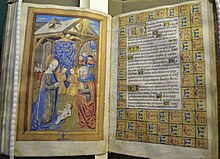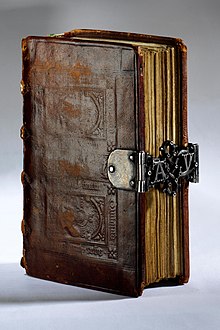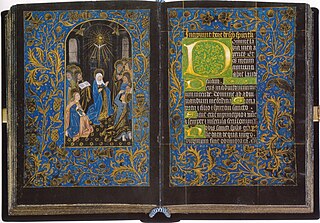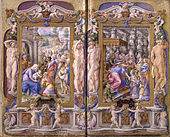Book of hours

Books of hours (
Books of hours were usually written in Latin (they were largely known by the name horae until "book of hours" was relatively recently applied to them), although there are many entirely or partially written in vernacular European languages, especially Dutch. The closely related primer is occasionally considered synonymous with books of hours–a medieval horae was referred to as a primer in Middle English[4]–but their contents and purposes could deviate significantly from the simple recitation of the canonical hours. Tens of thousands of books of hours have survived to the present day, in libraries and private collections throughout the world.
The typical book of hours is an abbreviated form of the
A typical book of hours contains the
History


The book of hours has its ultimate origin in the Psalter, which monks and nuns were required to recite. By the 12th century this had developed into the breviary, with weekly cycles of psalms, prayers, hymns, antiphons, and readings which changed with the liturgical season.[8] Eventually a selection of texts was produced in much shorter volumes and came to be called a book of hours.[9] During the latter part of the thirteenth century the Book of Hours became popular as a personal prayer book for men and women who led secular lives. It consisted of a selection of prayers, psalms, hymns and lessons based on the liturgy of the clergy. Each book was unique in its content though all included the Hours of the Virgin Mary, devotions to be made during the eight canonical hours of the day, the reasoning behind the name 'Book of Hours'.[10]

Many books of hours were made for women. There is some evidence that they were sometimes given as a wedding present from a husband to his bride.[9] Frequently they were passed down through the family, as recorded in wills.[9] Until about the 15th century paper was rare and most books of hours consisted of parchment sheets made from animal skins.
Although the most heavily illuminated books of hours were enormously expensive, a small book with little or no illumination was affordable much more widely,[7] and increasingly so during the 15th century. The earliest surviving English example was apparently written for a laywoman living in or near Oxford in about 1240. It is smaller than a modern paperback but heavily illuminated with major initials, but no full-page miniatures. By the 15th century, there are also examples of servants owning their own Books of Hours. In a court case from 1500, a pauper woman is accused of stealing a domestic servant's prayerbook.[citation needed]
Very rarely the books included prayers specifically composed for their owners, but more often the texts are adapted to their tastes or gender, including the inclusion of their names in prayers. Some include images depicting their owners, and some their
By at least the 15th century, the Netherlands and Paris workshops were producing books of hours for stock or distribution, rather than waiting for individual commissions. These were sometimes with spaces left for the addition of personalized elements such as local feasts or heraldry.

The style and layout for traditional books of hours became increasingly standardized around the middle of the thirteenth century. The new style can be seen in the books produced by the Oxford illuminator William de Brailes who ran a commercial workshop (he was in minor orders). His books included various aspects of the Church's breviary and other liturgical aspects for use by the laity. "He incorporated a perpetual calendar, Gospels, prayers to the Virgin Mary, the Stations of the Cross, prayers to the Holy Spirit, Penitential psalms, litanies, prayers for the dead, and suffrages to the Saints. The book's goal was to help his devout patroness to structure her daily spiritual life in accordance with the eight canonical hours, Matins to Compline, observed by all devout members of the Church. The text, augmented by rubrication, gilding, miniatures, and beautiful illuminations, sought to inspire meditation on the mysteries of faith, the sacrifice made by Christ for man, and the horrors of hell, and to especially highlight devotion to the Virgin Mary whose popularity was at a zenith during the 13th century."[11] This arrangement was maintained over the years as many aristocrats commissioned the production of their own books.
By the end of the 15th century, the advent of
Decoration

As many books of hours are richly illuminated, they form an important record of life in the 15th and 16th centuries as well as the
From the 14th century decorated borders round the edges of at least important pages were common in heavily illuminated books, including books of hours. At the beginning of the 15th century these were still usually based on foliage designs, and painted on a plain background, but by the second half of the century coloured or patterned backgrounds with images of all sorts of objects, were used in luxury books.
Second-hand books of hours were often modified for new owners, even among royalty. After defeating
Towards the end of the 15th century, printers produced books of hours with woodcut illustrations, and the book of hours was one of the main works decorated in the related metalcut technique.
The luxury book of hours
In the 14th century the book of hours overtook the psalter as the most common vehicle for lavish illumination. This partly reflected the increasing dominance of illumination both commissioned and executed by laymen rather than monastic clergy. From the late 14th century a number of
The most famous collector of all, the French prince
By the mid-15th century, a much wider group of nobility and rich businesspeople were able to commission highly decorated, often small, books of hours. With the arrival of printing, the market contracted sharply, and by 1500 the finest quality books were once again being produced only for royal or very grand collectors. One of the last major illuminated book of hours was the Farnese Hours completed for the Roman Cardinal Alessandro Farnese in 1546 by Giulio Clovio, who was also the last major manuscript illuminator.
Gallery
-
The Visconti Hours
-
Calendar page from the Hours of Catherine of Cleves for June 1–15.
-
Book of Hours of Jeanne d'Evreux: Arrest of Jesus and Annunciation
-
Book of hours of Simone de Varie, portrait of the owner and his wife
-
Book of Hours, British Library, theArrest of Christ
-
Scenes from the Life of Christ and Life of the Virgin in the same book
-
Les Très Riches Heures
du duc de Berry
A Funeral Service -
Bedford Hours; building the Tower of Babel
-
Deposition by
Jean Fouquet -
The Visitation, 1440–45
-
Printed Bulgarian book of hours, 1566
-
Llanbeblig Hours. St. Peter, holding a key and a book
-
The beginning ofhistoriated letters in Heures de Charles d'Angoulême
-
Saint Lifard with a dragon in the Grandes Heures of Anne of Brittany by Jean Bourdichon
Selected examples
See Category:Illuminated books of hours for a fuller list
In Europe
- Bedford Hours (c.1410–1430): London, British Library, Add. MS 18850
- Belles Heures of Jean de France, Duc de Berry (c.1405–1408/1409): Metropolitan Museum of Art, Cloisters Collection, 54.1.1a, b
- Black Hours of Galeazzo Maria Sforza (c.1466–1477): Vienna, Austrian National Library, Codex Vindobon. 1856
- Book of Hours (15th century): Milan, Biblioteca Trivulziana, Cod. 470
- Book of Hours (15th century): Paris, Bibliothèque nationale, MS lat. 10536 — one of the few early cordiform manuscripts still extant
- Book of Hours of Frederick of Aragon (1501–1502): Paris, Bibliothèque nationale, MS Lat. 10532
- Cobden Book of Hours: Bristol University Special Collections
- Grandes Heures of Anne of Brittany (1503–1508): Paris, Bibliothèque nationale, MS lat. 9474
- Hours of Étienne Chevalier (1450s) — sheets in several libraries
- Hours of Gian Galeazzo Visconti (late 14th century): Florence, Biblioteca Nazionale, Banco Rari 397 and Landau-Finaly 22
- Hours of James IV of Scotland (c.1503): Austrian National Library, Codex Vindobon. 1897
- Hours of Philip the Bold (late 14th century): Cambridge, Fitzwilliam Museum, MS 3-1954
- Howard Psalter and Hours (1310–1320): London, British Library, Arundel MS 83, pt 1
- Llanbeblig Book of Hours (1390–1400): Aberystwyth, National Library of Wales, NLW MS 17520A
- Petites Heures du Duc de Berry (1375×1385–1390): Paris, Royal Library, MS lat. 18014
- Primer of Claude of France (1505): Cambridge, Fitzwilliam Museum, MS 294 — simplified for a young princess
- Ravenelle Hours (15th century): Uppsala, UUB, MS C517e — a typical representative of books of hours made in Paris
- Rohan Hours (1430s): Paris, Bibliothèque nationale, MS lat. 9471
- Sforza Hours (commissioned c.1490, completed c.1517–1520): London, British Library, Add. MS 34294
- Taymouth Hours (c.1325–1335): London, British Library, Yates Thompson MS 13
- Très belles heures du Duc de Berry: Brussels, Royal Library of Belgium, 11060–11061
- Très belles heures de Notre-Dame du Duc de Berry: Paris, Bibliothèque nationale, nouv. acq. lat. 3093
- Très Riches Heures du Duc de Berry (c.1411–1416): Chantilly, Musée Condé, MS 65
- City Museum of Ancient Art, MS Inv. 47
- 'The De Brailes Hours', formerly known as 'The Dyson Perrins Hours' (1240): London, British Library, Add. MS 49999
In the United States
- Belles Heures of Jean de France, Duc de Berry (c.1405–1408/9): New York, Metropolitan Museum of Art, The Cloisters, 54.1.1a, b — miniatures of 'the Limburg Brothers'
- Black Hours (1460–1475): New York, Morgan MS 493 — an example of Black Hours, codices copied on black pages
- Farnese Hours (1546): New York, Morgan Library, MS M.69 — illuminated by Giulio Clovio
- Hours of Catherine of Cleves, property of 'Katharina van Kleef' (15th century): New York, Morgan Library, MSS M.917 and M.945
- Hours of Henry VIII: New York, Morgan Library, MS H.8 — with miniatures by Jean Poyer
- Hours of Jeanne d'Evreux (1325-1328): New York, Metropolitan Museum of Art, The Cloisters, 54.1.2
In Australia
- Rothschild Prayerbook (c.1500–1520): on display at the National Library of Australia in Canberra, owned by Australian businessman Kerry Stokes.
See also
- Agpeya
- Black books of hours
- Divine Service (Eastern Orthodoxy) and Horologion
- Grey-FitzPayn Hours
- Hours of Angers
- Hours of Charles V
- Hours of John the Fearless
- Hours of Peter II
- Liturgy of the Hours
References
- ^ Plummer, John (1966). The Hours of Catherine of Cleves. New York: George Braziller. pp. plates 1–2.
- ISBN 978-1-317-88952-6.
The book of hours was the favourite prayer-book of lay-people, and enabled them to follow, in private, the church's programme of daily devotion at the seven canonical hours.
- ISBN 978-1-60606-083-4.
- ^ Scott-Stokes, Charity (2006). Women's Books of Hours in Medieval England: Selected Texts Translated from Latin, Anglo-Norman French and Middle English with Introduction and Interpretative Essay. Library of Medieval Women. Woodbridge: Boydell & Brewer. p. 1.
- ^ Hore de Cruce, Danish Royal Library Archived December 24, 2008, at the Wayback Machine
- ^ "Lutheran Liturgical Prayer Brotherhood". Evangelisch-Lutherische Gebetsbruderschaft. Retrieved 16 April 2022.
In short, the Brotherhood Prayer Book is a fully catholic book of hours refracted through the lens of the Lutheran confessions.
- ^ a b "Middelnederlands getijdenboek" [Middle Netherlands Book of hours (lit. 'Tides book')]. lib.ugent.be. Retrieved 2020-08-27.
- ^ a b Duffy, Eamon (Nov 2006). "A Very Personal Possession: Eamon Duffy Tells How a Careful Study of Surviving Books of Hours Can Tell Us Much About the Spiritual and Temporal Life of Their Owners and Much More Besides". History Today. Vol. 56, no. 11. pp. 12(7).
- ^ a b c Harthan, John (1977). The Book of Hours: With a Historical Survey and Commentary by John Harthan. New York: Crowell.
- ^ Hirst, Warwick (2003). "The Fine Art of Illumination". Heritage Collection, Nelson Meers Foundation, 2003 (PDF). Sydney: State Library of New South Wales. pp. 8–9. Retrieved 17 Feb 2022.
- S2CID 108454672.
- S2CID 162374182.
- ISBN 0701124725.
- ^ "Getijdenboek van Alexandre Petau" [Book of hours of Alexandre Petau]. lib.ugent.be. Retrieved 2020-08-27.
Further reading
- Ashley, K.M. (2002) Creating Family Identity in Books of Hours. Journal of Medieval and Early Modern Studies, (1) 145–165.
- Calkins, Robert G. Illuminated Books of the Middle Ages. Ithaca, New York: Cornell University Press, 1983. ISBN 9780801415067
- Dückers, Rob, and ISBN 9789055445776
- Duffy, Eamon. Marking the Hours: English People and their Prayers 1240 - 1570. New Haven: Yale University Press, 2006. ISBN 0-300-11714-0
- ISBN 0-300-06076-9
- The Oxford Dictionary of Art ISBN 0-19-280022-1
- Pächt, Otto. Book Illumination in the Middle Ages (translation, Kay Davenport), London: Harvey Miller Publishers, 1986. ISBN 0-19-921060-8
- Simmons, Eleanor. Les Heures de Nuremberg, Les Editions du Cerf, Paris, 1994. ISBN 2-204-04841-0
- Wieck, Roger S. Painted Prayers: The Book of Hours in Medieval and Renaissance Art, New York: George Braziller, 2004. ISBN 978-0-8076-1457-0
- Wieck, Roger S. Time Sanctified: The Book of Hours in Medieval Art and Life, New York: George Braziller, 1988. ISBN 978-0807614983
For individual works
- The Hours of Mary of Burgundy (facsimile edition). Harvey Miller, 1995. ISBN 1-872501-87-7
- Barstow, Kurt. The Gualenghi-d'Este Hours: Art and Devotion in Renaissance Ferrara. Los Angeles: Getty Publications, 2000. ISBN 978-0-89236-370-4
- Clark, Gregory T. The Spitz Master: A Parisian Book of Hours. Los Angeles: Getty Publications, 2003. ISBN 9780892367122
- Meiss, Millard, and Edith W. Kirsch. The Visconti Hours. New York: George Braziller, 1972. ISBN 9780807613597
- Meiss, Millard, and Elizabeth H. Beatson. The Belles Heures of Jean, Duke of Berry. New York: George Braziller, 1974. ISBN 978-0807607503
- Meiss, Millard, and Marcel Thomas. The Rohan Master: A Book of Hours (translation, Katharine W. Carson). New York: George Braziller, 1973. ISBN 978-0807613580
- Porcher, Jean. The Rohan Book of Hours: With an Introduction and Notes by Jean Porcher. New York: Thomas Yoseloff, 1959.
- Manion, Margaret and Vines, Vera. Medieval and Renaissance Illuminated Manuscripts in Australian Collections, 1984. IE9737078
External links
General information
- Book of Hours - Harry Ransom Center of the University of Texas at Austin
- World Digital Library from partner - Library of Congress (Digital Books of Hours)
- "A Masterpiece Reconstructed: The Hours of Louis XII". Prints & Books. Victoria and Albert Museum. Archived from the original on 2011-02-02. Retrieved 2009-11-28.
- Sacred Image and Illusion in Late Flemish Manuscripts, Robert G. Calkins, Cornell University
- AbeBooks, Explaining Books of Hours with a varied selection of examples.
- 541 examples from the Digital Scriptorium
- Book of Hours Tutorial, Les Enluminures and the Morgan Library & Museum, MS M.1093
- Blog: PECIA/ Le manuscrit médiéval ~ The medieval manuscript Archived 2011-04-09 at the Wayback Machine
- Prints & People: A Social History of Printed Pictures, an exhibition catalog from The Metropolitan Museum of Art (fully available online as PDF)
- CHD Center for Håndskriftstudier i Danmark, founded by Erik Drigsdahl
Full "turn the pages" online individual manuscripts
- Lavishly illustrated Books of Hours, 12th through 16th centuries, Center for Digital Initiatives, University of Vermont Libraries
- The Sforza Hours at the British Library.
- Book of Hours, Use of Rome (the 'Golf Book'), c.1540, BL, Add MS 24098.
- Catholic Church. Book of hours Ms.Library of Congress. Rosenwald ms. 10, 1524. 113 leaves (23 lines (calendar 33 lines)), bound: parchment, col. ill.; 24 cm.
- Picturing Prayer, Books of Hours at Houghton Library, Harvard University.
- Book of Hours, of Premonstratensian Use at the Digital Archives Initiative Memorial University of Newfoundland.
- Late 15th Century French Book of Hours- De Villers Book of Hours, Digitized Collection: Utah State University.
- Book of Hours, circa 1430: University of Edinburgh MS 39.
The texts
- A Hypertext Book of Hours; full texts and translation
- Late Medieval and Renaissance Illuminated Manuscripts - Books of Hours 1400-1530 - An excellent guide containing tables describing all the various uses; also with original Latin texts and high-resolution photographs of many books.
- Books of Hours at the University of Pennsylvania Libraries - fully digitized with descriptions.

















